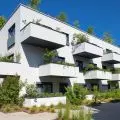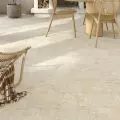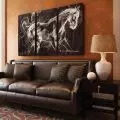Interview from A&B issue 04|2023
We talk to one of Sweden's most famous architects about how restrictions can become an effective way to bring us closer to the idea of freedom.
Swedish centers in nature reserves—nomen omen—are unique in the world. Designing this type of building is akin to programming a web-based interface: the goal is to tighten visitors' relationship with nature, and this places heavy demands on design and execution. Planning for the visitor center at Lake Tåkern began with a competition held in 2007.
This nature reserve is one of Europe's most important breeding sites for birds in spring, and a resting and feeding ground for migratory birds in autumn. An open lake with large expanses of reed beds (more than 13 square kilometers), with wet meadows, coastal forests and marshes surround the four nature reserves.
Tåkern became an attractive birding location in the mid-19th century, when landowners around the lake lowered the water level to drain the land and use it for crops. There were also proposals to drain the lake completely. This led to Sweden's first major conservation debate. Fortunately for future generations, not enough funds were raised to finalize the project once it was approved. The reed beds expanded, and aquatic plants thrived thanks to the shallow water's access to sunlight, providing habitat for insects, crustaceans and other invertebrates, which in turn became food for thousands of water birds.
The surrounding Östergötland region has a history of using reeds as a material in rural industries—Tåkern became a location attractive to birds in the mid-19th century, when landowners around the lake lowered the water level to drain wetlands and create new land that could be used for crops; this led to the first major conservation debate in Sweden
Photo: Åke Eson Lindman © Wingårdh arkitektkontor
The Naturum Tåkern information center in Glänås mimics the natural terrain of its surroundings. It's a low-lying structure—the result of 21st century thinking—whose building exterior is thatched with reeds. The local tradition of using reeds as a building material inspired architect Gert Wingårdh. Thatch is a practical material that can be easily restored if it becomes damaged. When laid on solid sheathing, air does not get underneath, preventing the possible spread of fire. The steep pitch of the roofs provides an estimated thatch life of more than fifty years. The roof and walls of the Naturum Tåkern building are covered with more than twenty-five centimeters of thatch and twenty centimeters of insulation, which together create a cozy shelter with a striking appearance. Steep roofs flow seamlessly into the walls. The ridge, usually the thatched roof is the most exposed precisely at this point, turns into a glazed skylight. This is quiet architecture, using local materials, redefining them through precise geometry.
The tradition of using reeds as a building material inspired architect Gert Wingårdh to use reed thatch on the exterior of the building; the steep pitch of the roofs gives the thatch an estimated life span of more than fifty years
Photo: Åke Eson Lindman © Wingårdh arkitektkontor
The building also uses other local materials: Borghamn limestone from Omberg Lake and pine from the surrounding forests of Östergötland County. The project thus establishes an even closer dialogue with the past. It's an architecture that opens up to time and the changes organically inherent in the life of the landscape and the building itself.
The interior of the observatory features a contemporary design, there are skylights and a high open space used for air shows. Under the skylight hang replicas of flying dragonflies and butterflies. A sculpture of a goose in flight has been installed in one of the display areas, referring to the children's story of the boy Niles, who roamed the Swedish countryside on the back of a goose, learning about nature, geography and folklore.
The ridge (usually the thatched roof is most exposed at this point) turns into a glazed skylight—the roof and walls of the Naturum Tåkern building are covered with more than twenty-five centimeters of thatch and twenty centimeters of insulation, which together create a cozy shelter with a striking appearance
Photo: Åke Eson Lindman © Wingårdh arkitektkontor
A conversation with Gert Wingårdh, a leading Swedish architect who has brought Swedish architecture out of the tradition of the International Style and into the modern age with his intuitive, sensual handling of massing and love of eye-catching materials.
Gert Wingårdh—Born in 1951, he is a Swedish architect. After studying art history and economics, he chose a career as an architect. He graduated from Chalmers University of Technology. His architectural office is based in Gothenburg, Stockholm and Malmö. His style is characterized by a sensual, intuitive handling of geometric solids and juxtaposing them with visually appealing, out-of-the-box materials.(Photo: Andy Liffner © Wingårdh arkitektkontor)
Ania Diduch: How does being an only child affect your creative work?
Gert Wingårdh:I think this fact is no longer deferred in my practice as an architect. I got a lot of attention from my mother, who was a full-time housewife. She wanted me to become a doctor and always felt betrayed that I wasn't fulfilling her wishes. The sense of paying attention is deep within me, so much so that I no longer think about it today.
Ania: Apparently, before you became an architect, you considered a profession as an art gallery owner.
Gert: My great-grandfather was an entrepreneur, developing various businesses related to agriculture; my grandfather was active in the cement industry. So my father was going to be involved in the business, and he was also interested in art. He wanted me to be a painter and freely chose my profession. And so jumping between different fields, I decided that I wanted to be a marshal. The first step in this direction was to study art history to gain a basic knowledge of the subject. I also studied economics as a complementary major. This is where my understanding of architecture came from: I began to understand it as a bridge between the bourgeoisie and the rest of the culture. So when I started studying architecture, my other interests began to merge into this one discipline. Then, too, it was the easiest way to find a job and be a professional in my profession.
Ania: What kind of art were you interested in then?
Gert: I was very interested in Marcel Duchamp, his complexity and contradictions of found objects (found objects). It was a perfect example of how art can exist on more than one level, expanding its boundaries. Then, of course, there was the influence of Warhol and his Interview magazine; I was inspired by this lifestyle. It was also important to immerse myself in the French cinema of the time, the films of Jean-Luc Godard and François Truffaut. It was a window into how representatives of the bourgeoisie in Europe live: they eat well, have a mistress, do nothing—they exist.
Ania: Nature is a force. Do you think architecture is, in its essence, a force in line with it, or in conflict with it?
Gert: They are different forces. I think architecture sets limits and formulates invitations. As for nature, it usually seems unlimited, broad. So in a sense, the two energies are opposed to each other. Sometimes architecture design blurs the boundaries between the two, but mostly it comes down to creating a form that fits well into the context.
Ania: While we're on the subject, what were the main reasons behind the decision to use reeds as a material in Naturum Tåkern?
Gert: The reason was the context precisely and the location. When you arrive at the site, you realize that the lake is really shallow, about a meter deep. As a result, you can hardly see the water, because the straws are only slightly higher than the surface of the water. So you have to climb up to the platform to see the birds all over the lake. On top of that, the lake freezes during the winter. So it was a very intuitive combination that led us to choose this material. It seemed like a good idea, because the whole complex is made for observing bird life.
Reed is not the only local material used in the building: also used were Borghamn limestone from the lake in Omberg and pine from the surrounding forests of Östergötland County
Photo: Åke Eson Lindman © Wingårdh arkitektkontor
Ania: Naturum Tåkern was established ten years ago. Are you keeping track of how it has aged?
Gert: Yes, it is on the route between Stockholm and Gothenburg, sometimes I find time to go there by car. The whole place is turning gray and yellowish in places, so I would say it is aging well.
Ania: Was it difficult to use straw as a material in those days?
Gert: No, not really. Although there were not many entrepreneurs in Sweden who could do it, it was easier to find suitable contractors in other Baltic countries.
Ania: I understand your approach to design to be very intuitive. Does it require a lot of site visits and getting to know the space of the future project?
Gert: I think intuition comes with life experience. And this is where the French approach to creation comes in again. Living „in the French way”, the most important thing is to be intuitive and insightful. I really like to design without visiting a location, because I am easily seduced by the environment and its beauty. This creates anxiety and distracts me from looking objectively for the best solutions. Of course, I always visit the space I am designing for, but I try to pull it off.
Reed is not the only local material used in the building: also used were Borghamn limestone from the lake in Omberg and pine from the surrounding forests of Östergötland County
Photo: Åke Eson Lindman © Wingårdh arkitektkontor
Ania: What feelings did you want to evoke in visitors to Naturum Tåkern?
Gert: The main idea was to create a sense of refuge, a space where one can feel safe and cozy to observe the landscape and its life.
Ania: What is your favorite part of nature?
Gert: I live by the sea, so I feel attached to the water. But I like to travel in the air the most.
Ania: Thank you for the interview.
interviewed: {tag:AutorAiB}
photo: Åke Eson Lindman
© Wingårdh arkitektkontor




































